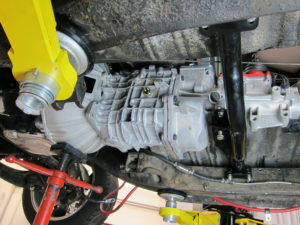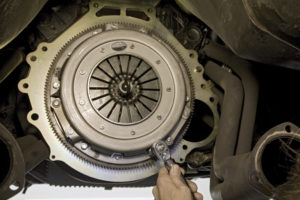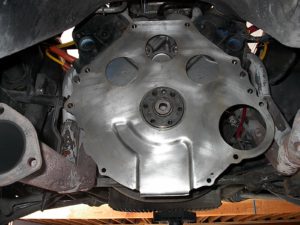TECH GUIDE: Swapping to a Manual Transmission
NEW OR USED PARTS FOR TRANSMISSION SWAP ? GOOD QUESTION.
A Donor Car
Though it’s easy to predict some things that you’ll need, other parts may be unwelcome surprises.
In order to deal with these parts, people will sometimes purchase what’s known as a donor car and strip it down in order to get the components that they need that are year specific.
The trouble with this is that you’re essentially doing twice the work, and you’re doing it at the same time.
Very few people have a garage large enough to accommodate this process. Ultimately, it is one of the less expensive options, but it also means that you may be getting parts of questionable quality.
The benefits of using a donor car are that they typically are had for very little money, and depending on the parts you strip off, you may be able to sell some to recoup some of the cost.
Piece by Piece
On the other hand, it’s possible to piecemeal a new driveline simply by purchasing a high quality used parts. You can find these through a junkyard, a local mechanic, or even through an online site like eBay. These tend to be a little more of a sure thing than getting your parts out of a donor car, but it does also tend to be more expensive (though admittedly in small bursts, so if your plan is to buy pieces over a long period of time, this may be less to bite off at once), and you need to research to ensure that all the components that you’re purchasing are capable of working together. Sometimes car manufacturers make small, not particularly well-advertised, changes to things as small as the bolt on a pedal assembly and suddenly you’re scrambling to find a fix.
Buying New
The route that guarantees the most in terms of reliability is not coincidentally a little more expensive. Buying new parts usually confers some type of warranty or guarantee of quality as well, and typically brands really believe in their product and will work with you to make sure that you’re satisfied with the overall results.
There’s no reason to stick to one route or the other. As long as the parts you purchase are compatible with each other, it won’t matter if one part is new and another is old.
With regards to compatibility, one of the easiest things you can do that will help your transmission swap be successful is simply to buy the manual transmission that was designed for the model car that you’re working with. This obviously isn’t an option if there wasn’t a manual option, but for most cars, you can find a manual transmission that was designed to fit in the body of your car. The nice thing about that is that most of the hoses and connections will be approximately the same length, resulting in fewer new parts and minor inconveniences for you.
Just a couple of short videos on a used transmission with hidden surprises.
VIDEO: Bad Throw-out bearing will not slide off the input shaft easily
VIDEO: Bad Throw-out bearing caused damage to input shaft not seen until bearing was removed
WHAT KIND OF JOB WILL THIS BE?

To install A manual transmission into a car that currently has an automatic, you’ll also need a Bellhousing, new clutch, flywheel, shaft assembly, and pedal assembly.
Unfortunately, even the brake pedal of your existing pedal assembly isn’t compatible and will need to be altered.
You’ll also likely need a host of smaller components depending on the scope of the project.
If you’ve already committed to changing the transmission then you may want to change the engine at the same time.
This makes the transmission swap a little bit simpler and for older cars is generally a good investment anyway since it’s likely that the engine has a good number of miles on it.
This is entirely up to you, but since you’re going through the effort of making a transmission “mate” to an engine, you may want to make sure that you’re doing this once.
It’s a good time to install additional modifications as well, like a short-throw shifter, or a new exhaust system.
There are a lot of other upgrades that can be done at the same time without adding a lot of additional work since you’ll be moving around so many things anyway.
PARTS NEEDED
This should give you an idea of the parts that are commonly needed.
Though everyone is prepared for needing a transmission, it’s important to think about everything you need before you get started.
- Flywheel
A flywheel is the part of a manual transmission that connects to the engine - Flywheel Bolts
You should never re-install Flywheel bolts if they are used, as they will be heat-stretched and their tensile strength compromised. - Bellhousing
A bellhousing is needed when swapping from n automatic to a manual transmission, in certain cases if you already have a manual we can use your existing bellhousing - Clutch Disc
A clutch disc is the portion of a manual transmission that connects to the transmission. - Pressure Plate
The pressure plate applies pressure to the clutch disc in order to engage and disengage the clutch. - Pedal Assembly
The pedal assembly refers to the pedals inside the car that allow you to communicate with the clutch and the engine. - Clutch Fork
An external hydraulic slave cylinder
An internal slave throw-out bearing
The clutch fork transfers pedal movement pressure to the throwout bearing.
The External Slave components do the same but are hydraulically driven.
An Internal Slave throw-out bearing eliminates the clutch fork and the throw-out bearing engages with the clutch and is hydraulically driven. - Throw out Bearing / Slave Cylinder
The throw-out bearing presses against the center of the diaphragm spring, causing the pressure plate to push against the clutch disc.
This can be actuated mechanically, by cable or hydraulically. - Clutch Alignment Tool
This is optional, but there’s a reason these parts come with clutch kits. Using this tool will ensure that the flywheel, clutch disc, and pressure plate line up correctly. - Pilot Bushing
This piece supports the input shaft and clutch disc while allowing the flywheel to maintain an engine’s RPM even as the input shaft is slowing. - Bolts
Kind of goes without saying, but these are the pieces that secure everything. You will need a lot of them, in a variety of shapes depending on your choices. - Clutch Cable and Quadrant
You’ll need a way to communicate with the clutch, and a cable is important for that goal. The quadrant makes that cable adjustable.
If you choose to go hydraulic these are not needed. - Crossmember
This is the piece that holds the transmission to your car. - Mount
A buffer piece usually rubber that goes between your Crossmember and Transmission to absorb minor vibrations - Driveshaft
The driveshaft carries power from the transmission to your car’s differential. Lengths vary considerably, and driveshafts come in a variety of materials - Yoke
A slip yoke sits in the spine of the tail shaft of your transmission and your existing driveshaft can be shortened to a newly adjusted length for your application.
PREPARING CAR FOR NEW TRANSMISSION

The first step to any transmission swap is going to be removing the existing transmission. Because you’ll be installing a different transmission instead of simply a new one, this is actually a good time to go ahead and remove a whole lot more than that. Removing the center console, front seats, carpet, and knee bolster will ensure that you have an adequate workspace for the transmission swap, and you can go ahead and stow some of these parts (like the seats) away from your work site so that they don’t end up streaked in grease. You can also go ahead and remove the pedal assembly as well.
Once you have lowered the existing transmission out of your car, you can go ahead and start to perform the critical first steps.
INSTALLING NEW TRANSMISSION
It’s incredibly important to refer to your manual throughout this process, and when in doubt, double-check. Even something small, like over or under torquing a bolt, can have negative consequences for your transmission swap.
You’ll be replacing the flexplate on your engine with a flywheel. It may be tempting to try to reuse the bolts from your flexplate for the flywheel, but usually, flywheel bolts will be shorter.
From there, you’ll connect the clutch plate, the pressure plate, and then the bellhousing. Don’t forget to use your clutch alignment tool (check a few times through the process) to make sure that everything is where it needs to be.
Once you’ve got those components in place, you can lift your new transmission into place and bolt it in using the cross member.
Next, you’ll add the pedal assembly. This requires getting up under the dash, so if you have a small trustworthy child who has an interest in cars, it may be time to enlist their help with some quality “bonding” time.
This is obviously a very abbreviated version of the steps that are necessary, but hopefully, it gives you an overview of the size of the task you’re considering undertaking.
Please log in to leave a comment.
No Comments Yet